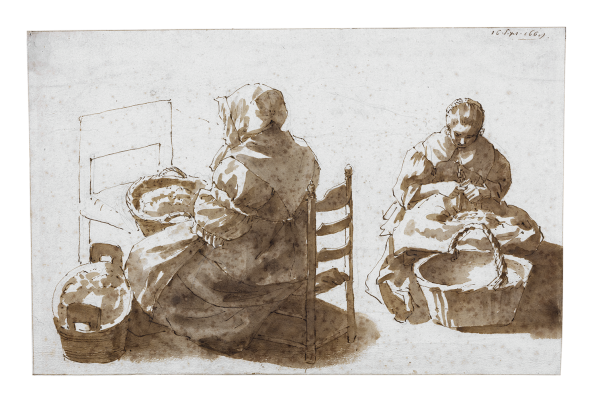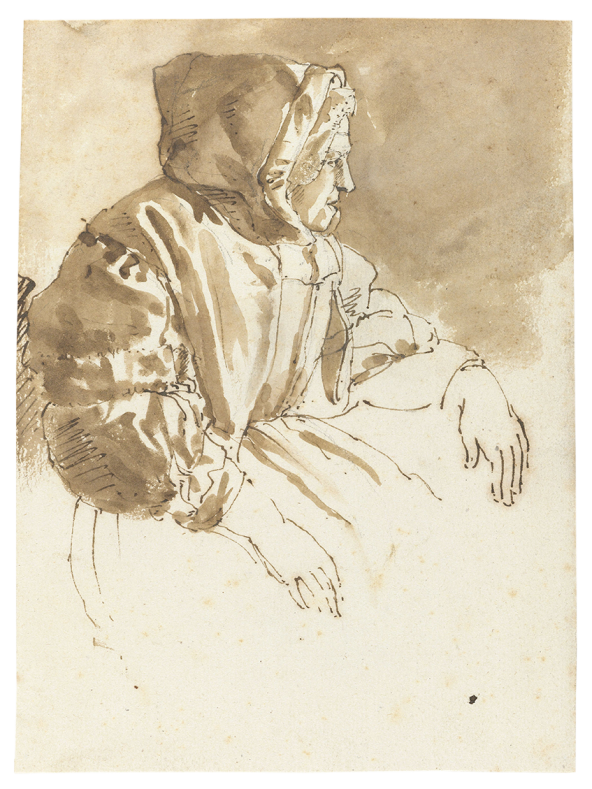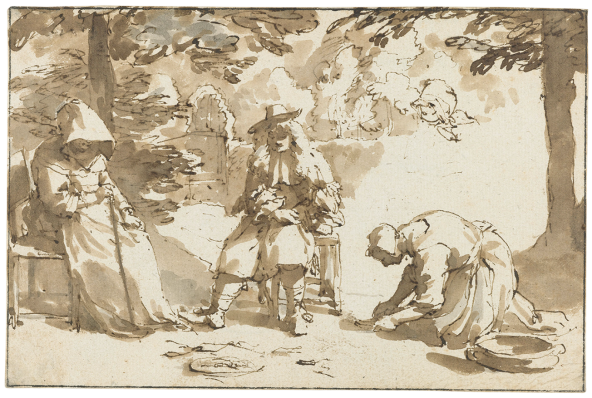Choose a background colour
Constantijn Huygens II, Dutch, 1628-1697
:
Study of a Seated Woman, c. 1665-70
Pen and brush in brown ink on paper; framing lines in black over brown ink.
4 7⁄8 × 3 3⁄4 in. (12.4 × 9.6 cm)
Recto, lower right in pen, bisschop (in an early hand, not by the artist).
- Chain Lines:
- Indiscernible.
- Watermark:
- None.
- Provenance:
Possibly Samuel van Huls, 1655 – 1734, The Hague; possibly his sale, The Hague, 14 May 1736, within lot 1686 (as Jan de Bisschop: “deux femmes assises, et 5 autres”); unidentified collector with Q mark (Lugt 4974, stamp on recto); sale, Sotheby Mak van Waay, Amsterdam, 21 March 1977, lot 24 (as Jan de Bisschop); F. W. A. Knight, Esq.; his sale, Sotheby Mak van Waay, Amsterdam, 29 October 1979, lot 19 (as Jan de Bisschop); Sheldon and Leena Peck, Boston (Lugt 3847); gift to the Ackland Art Museum, inv. no. 2017.1.5.
- Literature/Exhibitions:
None.
- Ackland Catalogue:
- 2017.1.5
With broken ink outlines, spacious hatching, and broad strokes of diluted ink, Constantijn Huygens deftly captured the formidable appearance of this older woman. Huygens worked as a court official for Stadholder-King William III (1650-1702), but had trained in draftsmanship with his father from an early age. In adulthood, he attended an informal drawing academy to sketch from live models with other amateurs, such as lawyer and dilettante Jan de Bisschop.
This drawing was once attributed to De Bisschop. The style and subject of the work, however, point to Huygens’s authorship. Based on other sheets by the artist, the sitter here might be Catharina Suerius, a cousin of Huygens’s mother, who raised him after his mother’s early death.
Constantijn Huygens II was not a professional artist, but rather one of the most highly placed members of the court of the Stadholder-King William III (1650 – 1702), serving as his secretary, just as his father Constantijn Huygens I (1596 – 1687) served as secretary for the Princes of Orange before him.1
His father had all of his children trained in draftsmanship from a young age and imparted much of his passion for art to them, though none continued to draw throughout life quite as avidly as Constantijn the Younger. He frequently managed to achieve brilliant effects in his pen and wash drawings, and is especially known today for the many landscape drawings he made while traveling. Constantijn remained close to his brother Christiaan Huygens (1629 – 1695), the famous scientist and inventor of the pendulum clock, with whom he frequently discussed matters of art and collecting.2
He was also good friends with the prominent lawyer and fellow dilettante Jan de Bisschop (1628 – 1671), with whom his drawings have often been confused.3
Such a misidentification was indeed the case with the present sheet, which bears De Bisschop’s name in the lower right corner, probably added by a collector or dealer at some point in the eighteenth century. The style of draftsmanship, however, is clearly that of Huygens.4 Similar figures can be found in Huygens’s drawing in the Groninger Museum showing two women with baskets preparing or peeling vegetables Fig. 58.1.5

Constantijn Huygens II, Two Seated Women at Work, 1668. Pen and brush in brown ink, 176 × 270 mm. Groningen, Groninger Museum, inv. no. 1931.0138.
Collection Groninger Museum, loan from Municipality of Groningen, donation Hofstede de Groot. Photograph Marten de Leeuw
Another in the Rijksmuseum depicts a similarly seated old woman in profile, whose facial characteristics and seemingly gruff demeanor even suggest the same sitter as here Fig. 58.2.6

Constantijn Huygens II, Old Woman in Profile, c. 1638 – 97. Pen and brush in brown ink, over sketch in graphite or black chalk, 150 × 111 mm. Amsterdam, Rijksmuseum, inv. no. rp-t-1989-127.
Rijksmuseum, Amsterdam
She has comparably angular features and a long nose, and wears a similar collar with long points draped over her chest. Huygens tended to use broad, loose hatching in places, and outlined his figures with thin and sometimes broken pen lines, as seen in both of these drawings. Huygens’s relaxed and broad handling of the brush for the wash additions also sets his works apart from those of De Bisschop. It was not until Jan van Gelder published his groundbreaking article in 1978 that some of these genre subjects were convincingly identified as the work of Huygens on the basis of style, inscriptions, and his “superior powers of observation,” including the aforementioned sheet in the Groninger Museum.7
Van Gelder also pointed to similar studies of women in profile or seen from behind in collections in Rotterdam and Brussels.8
Huygens was frequently in the habit of writing the exact date on his drawings, which he did in his characteristic and easily identifiable hand, and the sheets in Brussels and Groningen both bear dates of 1666 and 1668 respectively. A date around these years seems reasonable for the present work as well, especially since none of his similar drawings of women have been dated outside of this range, though he did make figure studies sporadically throughout his life.
The long-standing confusion between drawings by Huygens and De Bisschop arose not only from their close artistic relationship, but also because Huygens’s drawings were nearly unknown to early collectors. His name rarely features in eighteenth-century sales catalogues, and many of the abovementioned works were unwittingly grouped together with De Bisschop’s drawings in early sales.9
It is quite possible that the present sheet was once part of the same group of around 100 drawings thought to be by De Bisschop that appeared in the sale of the collection of Samuel van Huls in 1736, in which one lot is described as “two seated women” (probably the Groningen sheet, now given to Huygens), “and five others.” 10
The Rijksmuseum’s Old Woman in Profile likewise came from a mixed group of De Bisschop’s and Huygens’s drawings sold as one lot in the early 1840s.11
Huygens’s voluminous diary is one of the most extensive to survive from his era, and it has helped greatly in clarifying the many landscape drawings he made on his travels that compose most of his oeuvre.12
His corpus of genre scenes and figure studies is much smaller by comparison and remains difficult to elucidate, especially for this period in the late 1660s when he stayed closer to home. We know from letters that he and Jan de Bisschop, along with a few other amateurs, would regularly draw from live models as part of an informal drawing academy around this time.13
The Peck drawing may have easily resulted from one of their sessions. It is more tempting, however, to consider that this striking woman, who exudes a great deal of personality despite her voluminous coverings, stemmed from Huygens’s familial surroundings. He was certainly in the habit of depicting friends and family members, as attested by his 1669 drawing of his brother Lodewijk casually playing cards.14
In this light, Marijn Schapelhouman’s suggestion that the Old Woman in Profile in the Rijksmuseum might depict Catharina Suerius, or Zuerius (c. 1590/1600 – 1680), has much to recommend it and might be applicable to the present drawing as well.15
She was the cousin of Huygens’s mother, Susanna van Baerle (1599 – 1637), who died when Constantijn and his siblings were still quite young. Catharina stepped in to raise the children and remained a part of the household. Another drawing that possibly depicts her, made in the 1660s by Jan de Bisschop, is inscribed by a contemporary hand on the verso describing the scene as Constantijn Huygens the Younger at Hofwijck (the family’s country estate) with his moeij—an antiquated term meaning aunt or cousin Fig. 58.3.16

Jan de Bisschop, Constantijn Huygens II in the Garden at Hofwijck, c. 1648 – 71. Pen in brown ink, brush in brown and gray ink, 99 × 150 mm. Amsterdam, Rijksmuseum, inv. no. RP-T-1899-A-4263.
Rijksmuseum, Amsterdam
This term might easily have been applied to Catharina given her position in the household. We have no certain images of her, but it is nevertheless enticing to consider that Constantijn later in life would be compelled to make such incisive images of this woman who raised him from the age of nine. Our only tidbit of knowledge of her personality comes from Constantijn’s father, who apparently considered her something of a nag (zeur—perhaps a play on her name?) and was apparently annoyed by her opinion that he should remarry, which he never did.17
It is certainly an impression that seems compatible with the image of the imposing woman in front of us. Whatever the case, and whether or not she was a member of Huygens’s family, the formidable figure set forth on this previously unpublished sheet is a welcome addition to the small body of intimate figure studies by an artist who is mostly known for his landscapes.
End Notes
For the life and career of Constantijn Huygens II, see Dekker 2013. For his artistic activities, see especially Amsterdam & Ghent 1982 – 83; as well as Dekker 2013, 67 – 87; and Van Gelder 1978.
The confusion of his oeuvre with De Bisschop’s is the primary subject of Van Gelder 1978, following up on initial remarks made in Van Gelder 1971, 212, note 49. For the relationship between the two artists, see also Jellema & Plomp 1992, 16 – 17; and Keesing 1993. One of the strongest statements about their friendship is found in De Bisschop’s dedication of the first volume of his Icones in 1668 to Huygens; for which see Van Gelder & Jost 1985, vol. 1, 89 – 90 (for the English translation by D. Freedberg), and vol. 2, 1 – 4 (for the original Latin and Dutch texts).
My thanks to Marijn Schapelhouman for confirming this attribution based on a digital image (email correspondence, 26 March 2021).
Bolten 1967, 51, 140, no. 11 (as a drawing by Jan de Bisschop).
M. Schapelhouman in Amsterdam 1989, 90 – 91, no. 48.
Rotterdam, Museum Boijmans Van Beuningen, inv. no. CdB1 (Van Gelder 1978, fig. 16); and Brussels, Koninklijke Musea voor Schone Kunsten van België, inv. no. De Grez 1750 (Van Gelder 1978, fig. 19).
See Van Gelder 1978 for a number of examples. For the 1823 auction catalogue of the collections of J. Stinstra et al. that correctly lists a large group of landscape drawings under Huygens’s name, see Amsterdam & Ghent 1982 – 83, 197 – 98 (Appendix B).
See Bolten 1967, 51, under no. 11, note 1.
Amsterdam 1989, 90 – 91, no. 48, with the full provenance given in idem, 76, under no. 31.
For the diary, see Dekker 2015; and for the interrelationships with his landscape drawings, see Amsterdam & Ghent 1982 – 83.
Van Gelder 1971, 211; and Jellema & Plomp 1992, 64 – 65.
Amsterdam, Rijksmuseum, inv. no. RP-T-1989-126; see Schapelhouman in Amsterdam 1989, 89 – 90, no. 47.
M. Schapelhouman in Amsterdam 1989, 90 – 91, no. 48.
The inscription on the verso reads: d Heer van Zeelen [Huygens’s title, the Lord of Zeelhem] op Hofwijck en zijn moeij. For this drawing, see Van Gelder 1957, 40, no. 3; and New York, Boston & Chicago 1972 – 73, 20 – 21, no. 10; both suggesting that the older woman might be one of Huygens’s actual aunts, Geertruyd Huygens-Doublet (1599 – 1680). For the suggestion that she is Catharina Suerius, see Amsterdam & Ghent 1982 – 83, 15; and Van Strien & Van der Leer 2002, 96. Her identity in this drawing would of course be impossible to confirm against a likeness since her face is covered with a hood, but it is worth noting that an extant portrait of Geertruyd from 1668 (see Van Gelder 1957, 10 – 11, no. 2, pl. 8) shows a woman with broader and less angular features than those in the present sheet and the aforementioned Old Woman in Profile in the Rijksmuseum. Those features do, however, better match another drawing by Huygens in the Rijksmuseum, Old Woman Asleep (inv. no. RP-T-1989-128); for which see Amsterdam 1989, 90 – 91, no. 49.
L. van der Vinde in Voorburg 2010, 47.
